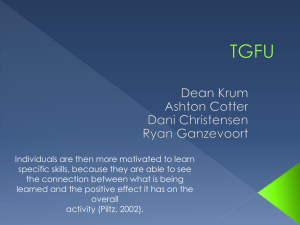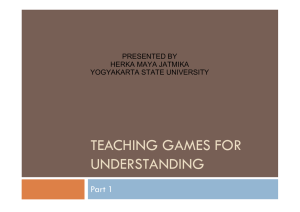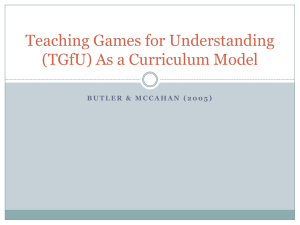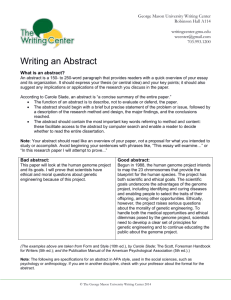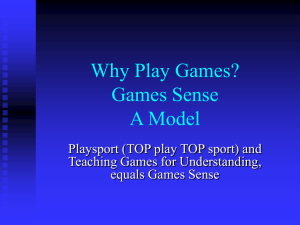File
advertisement
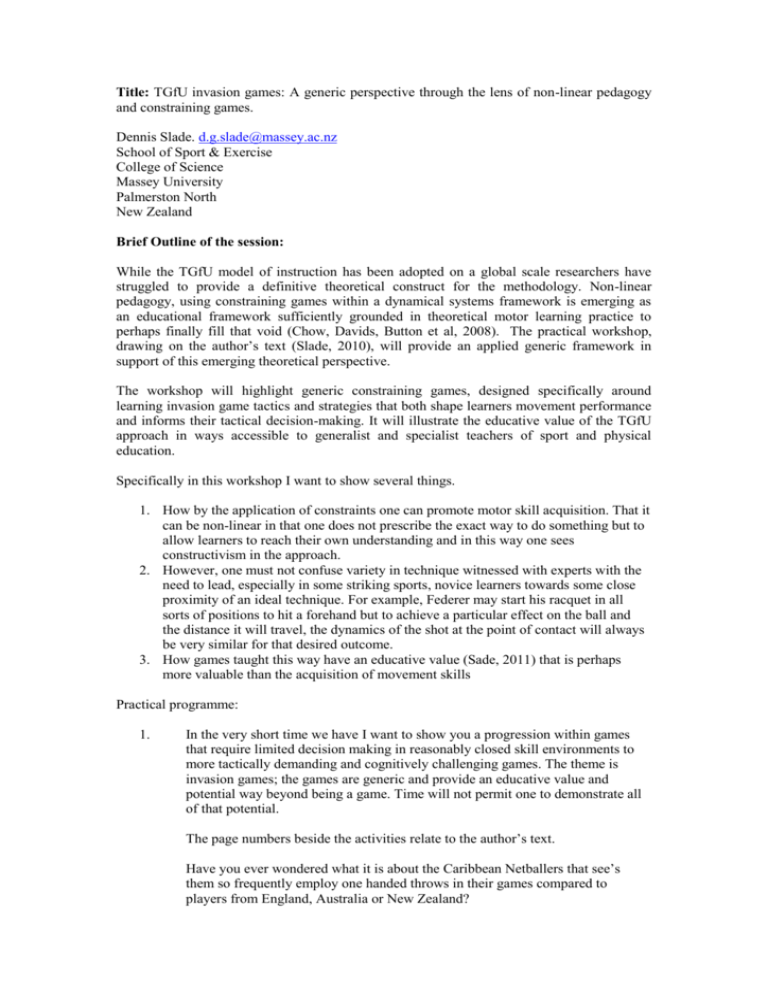
Title: TGfU invasion games: A generic perspective through the lens of non-linear pedagogy and constraining games. Dennis Slade. d.g.slade@massey.ac.nz School of Sport & Exercise College of Science Massey University Palmerston North New Zealand Brief Outline of the session: While the TGfU model of instruction has been adopted on a global scale researchers have struggled to provide a definitive theoretical construct for the methodology. Non-linear pedagogy, using constraining games within a dynamical systems framework is emerging as an educational framework sufficiently grounded in theoretical motor learning practice to perhaps finally fill that void (Chow, Davids, Button et al, 2008). The practical workshop, drawing on the author’s text (Slade, 2010), will provide an applied generic framework in support of this emerging theoretical perspective. The workshop will highlight generic constraining games, designed specifically around learning invasion game tactics and strategies that both shape learners movement performance and informs their tactical decision-making. It will illustrate the educative value of the TGfU approach in ways accessible to generalist and specialist teachers of sport and physical education. Specifically in this workshop I want to show several things. 1. How by the application of constraints one can promote motor skill acquisition. That it can be non-linear in that one does not prescribe the exact way to do something but to allow learners to reach their own understanding and in this way one sees constructivism in the approach. 2. However, one must not confuse variety in technique witnessed with experts with the need to lead, especially in some striking sports, novice learners towards some close proximity of an ideal technique. For example, Federer may start his racquet in all sorts of positions to hit a forehand but to achieve a particular effect on the ball and the distance it will travel, the dynamics of the shot at the point of contact will always be very similar for that desired outcome. 3. How games taught this way have an educative value (Sade, 2011) that is perhaps more valuable than the acquisition of movement skills Practical programme: 1. In the very short time we have I want to show you a progression within games that require limited decision making in reasonably closed skill environments to more tactically demanding and cognitively challenging games. The theme is invasion games; the games are generic and provide an educative value and potential way beyond being a game. Time will not permit one to demonstrate all of that potential. The page numbers beside the activities relate to the author’s text. Have you ever wondered what it is about the Caribbean Netballers that see’s them so frequently employ one handed throws in their games compared to players from England, Australia or New Zealand? 1.1 Corner ball / Space Pass / Connect 3 – constrained but outcomes include movement fundamentals but also: head position, looking, and use of wide and long space, man to man marking. pp 23; 29 1.2 Outlet: Constrained around movements but constraint forces a zone and sliding zone defence. TGfU Teaching moment. pp 52; 55 1.3 Three Zone Pass: Concept of attack to defensive transitions while learning concepts of roles in games and thinking about force ratios pp74 1.4 Touch Down: Simple but fun game that introduces concepts associated with a press and player support. pp 81 1.5 Obviously not the time but the next step would be looking at fast breaks Most of the work for this session is taken from the author’s text: Slade, D.G. (2010). Transforming play: Teaching tactics and game sense. Champaign Ill. Human Kinetics NB. Both sessions were not identical. After the first session and in response to a question I added in a small fast break game. I did this to illustrate my concept of mandate teaching. In the other games one could use a chest type pass to play almost all of the games however, in the Fast Break game the breakout to a high player required a single handed over-arm throw to effect the attack in this manner. Of course if students could not complete or perform this throw it then provides a mandate to spend a little time to provide direct instruction and drill practice – 2 -4 minutes before returning to the game to put the use of the throw in context. This game is not in my text and currently I only have a ‘free hand’ drawing of it. If anyone would like a copy of that game you can contact me by e-mail (d.g.slade@massey.ac.nz) and I’ll send it to you. For those of you in my second (Sunday) session you may recall the game was extremely fast and resembled shuttle runs! Regards Dennis Slade

